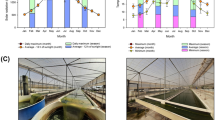Abstract
The aim of this study is to investigate the effect of the N/P ratio on biomass growth with the simultaneous removal of nutrients from municipal wastewaters. An optical panel photobioreactor is employed for this investigation because it provides a uniform light distribution within the reactor, which enhances the efficiency of the reactor in the cultivation of microalgae. The N/P ratio is varied over a wide range, i.e., from 5 to 30, for the assessment of its effect on biomass productivity. There is not a strong correlation between biomass productivity and TN removal, and these factors do not seem to be proportional in the wastewater using the microalgae we employed. In contrast, the TP removal depends greatly on both the N/P ratio and biomass productivity. The optimum value of the N/P ratio for biomass productivity in and nutrient removal from municipal wastewater treatment using microalgae varies from 5 to 30, depending on the ecological conditions in the wastewater.







Similar content being viewed by others
References
Wang C, Yu X, Lv H, Yang J (2013) Nitrogen and phosphorus removal from municipal wastewater by green alga Chlorella sp. J Environ Biology 34:421–425
Li X, Hu HY, Yang J (2010) Lipid accumulation and nutrient removal properties of a newly isolated freshwater microalga, Scenedesmus sp. LXI, growing in secondary effluent. New Biotechnol 27:59–63
Pittman JK, Dean AP, Osundeko O (2011) The potential of sustainable algal biofuel production using wastewater resources. Bioresour Technol 102:17–25
Kim J, Lingaraju BP, Theaume R, Lee J, Siddiqui KF (2010) Removal of ammonia from wastewater effluent by Chlorella vulgaris. Tsinghua Sci Technol 15:391–396
Clarens AF, Resurreccion EP, White MA, Colosi LM (2010) Environmental life cycle comparison of algae to other bioenergy feedstocks. Environ Sci Technol 44:1813–1819
Wijffels RH, Barbosa MJ (2010) An outlook on microalgal biofuels. Science 329:796–799
Klausmeier CA, Litchman E, Simon AL (2004) Phytoplankton growth and stoichiometry under multiple nutrient limitations. Limnol Oceanography 49:1463–1470
Klausmeier CA, Litchman E, Daufresne T, Levin SA (2004) Optimal nitrogen-to-phosphorus stoichiometry of phytoplankton. Nature 429:171–174
Kong QX, Li L, Martinez B, Chen P, Ruan R (2010) Culture of microalgae Chlamydomonas reinhardtii in wastewater for biomass feedstock production. Appl Biochem Biotechnol 160:9–18
Nieuwerburgh LV, Wänstrand I, Snoeijs P (2004) Growth and C:N: P ratios in copepods grazing on N- or Si-limited phytoplankton blooms. Hydrobiologia 514:57–72
Redfield AC, Ketchum BH, Richards FA (1963) The influence of organisms on the composition of sea-water. In: Hill N (ed) In the Sea, 2nd edn. Wiley, New York, pp 26–77
Falkowski P, Barber R, Smetacek V (1998) Biogeochemical controls and feedbacks on ocean primary productivity. Science 281:200–206
Geider RJ, Roche JL (2002) Redfield revisited: variability of C:N: P in marine microalgae and its biochemical basis. Eur J Phycol 37:1–17
Choi HJ, Lee SM (2014) Effect of optical panel thickness for nutrient removal and cultivation of microalgae in the photobioreactor. Bioprocess Biosys Eng 37(4):697–705
APHA (1995) Standard methods for the examination of water and wastewater. American Public Health Association, Washington DC
Rhee GY, Gotham IJ (1980) Optimum N/P ratios and coexistence of planktonic algae. J Phycol 16:486–489
Hall SR, Smith VH, Lytle DA, Leibold MA (2005) Constraints on primary producer N: P stoichiometry along N: P supply ratio gradients. Ecology 86:1894–1904
Havens KE, James RT, East TL, Smith VH (2003) N: P ratios, light limitation, and cyanobacterial dominance in a subtropical lake impacted by non-point source nutrient pollution. Environ Poll 122:379–390
Choi HJ, Lee JM, Lee SM (2013) A novel optical panel photobiorector for cultivation of microalgae. Water Sci Technol 67(11):2543–2548
Fu RB, Zhu YP, Yang HZ, Gu GW (2008) Characteristics of microbial biomass in subsurface constructed wetland treating eutrophic water. Huan Hing Ke Xue 29(10):2754–2759
Hernandez JP, de Bashan LE, Bashan Y (2006) Starvation enhances phosphorus removal from wastewater by the microalga Chlorella Spp. Co-immobilized with Azospirillum Brasilense. Enzyme Microbial Technol 38:190–198
Fu Z, Yang F, Zhou F, Xue Y (2009) Control of COD/N ratio for nutrient removal in a modified membrane bioreactor (MBR) treating high strength wastewater. Bioresour Technol 100:134–141
Klausmeier CA, Litchman E, Daufresne T, Levin SA (2008) Phytoplankton stoichiometry. Ecol Res 23:479–485
Woertz I, Fulton L, Lundquist T (2009) Nutrient removal and greenhouse gas abatement with CO2 supplemented algal high rate ponds. Water Environment Federation, Orlando, Oct 12–14
Acknowledgments
This work was supported by the basic Science Research Program through the National Research Foundation of Korea (NRF) funded by the Ministry of Education, Science and Technology (2013006899).
Author information
Authors and Affiliations
Corresponding author
Rights and permissions
About this article
Cite this article
Choi, H.J., Lee, S.M. Effect of the N/P ratio on biomass productivity and nutrient removal from municipal wastewater. Bioprocess Biosyst Eng 38, 761–766 (2015). https://doi.org/10.1007/s00449-014-1317-z
Received:
Accepted:
Published:
Issue Date:
DOI: https://doi.org/10.1007/s00449-014-1317-z




